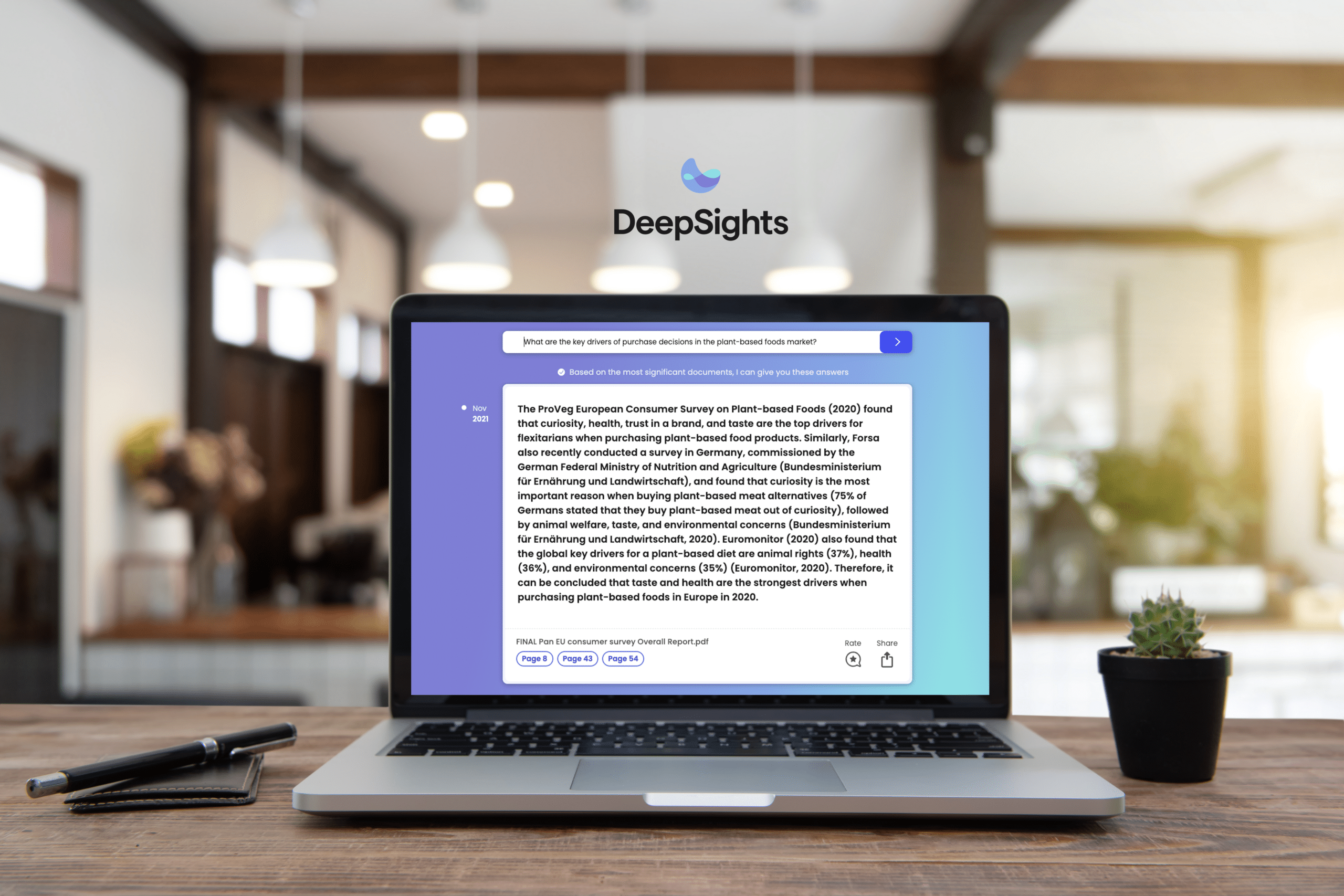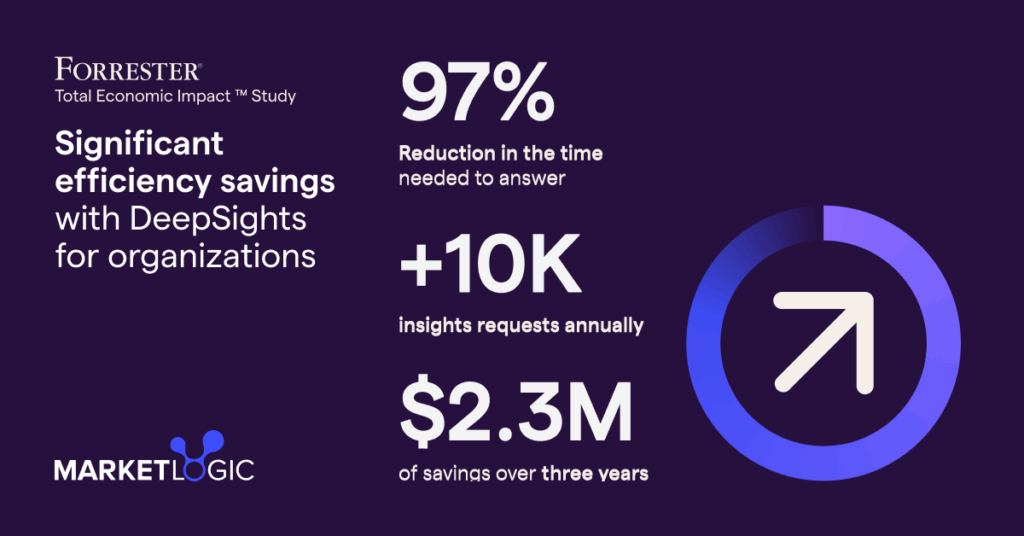Every year, hundreds of thousands of new products are introduced, many with significant resource and monetary investments. According to Clayton Christensen, a professor at Harvard Business School, 95% of the nearly 30,000 new products fail. Many do not meet customer expectations, while others are already outdated by the time of release. The result is the same with the vast majority of new products never achieving market success.
Even a single product failure impacts the organization for years, from both a reputational and a financial standpoint. As a result, many companies are hesitant to take bold steps when it comes to new products, which often results in lagging behind competitors that are more willing to innovate.
In fact, many organizations rely on traditional approaches for product development, such as using static market research. Product decisions are also often made based on a “gut feeling.” Market Logic research discovered that 40% of key decisions are made without using data. Additionally, many use stale data for manual or AI analysis.
These outdated methods do not take into account rapidly evolving customer preferences or economic shifts in the market. Companies using decade-old processes for research and development are increasingly vulnerable to market shifts and misaligned offerings.
By using AI-powered insights, companies have access to organizations that bring significant strategic advantage and increase the likelihood of successful innovation. Companies using data-driven approaches can turn the cloud of uncertainty surrounding new products into a clear path toward product success.

As a product or innovation leader, leveraging advanced data-driven technology can help you gain predictive foresight and strategic confidence in your product pipeline. This article delves into the common reasons that new products fail and then gives you a roadmap on how to use AI to create commercially successful products.
The high stakes of innovation: Why products fail
Redefining the product innovation process starts with understanding why so many new products never achieve commercial success or, even worse, devalue the brand due to negative reviews and sentiment.
Here are four common mistakes that organizations make when developing new products:
- Lack of deep market understanding: Your team needs to fully understand the target customer’s needs in order to design a product that helps overcome their challenges. Without this knowledge, new products most often do not meet real customer needs or address underserved segments.
- Ineffective competitive analysis: Your new product does not exist in a vacuum. The success of a product is not solely determined by its features and design. Successful products must either meet a need that is not filled by other products on the market or outperform other products. Products that do not differentiate themselves from other similar products or fail to capture market share often fail.
- Using siloed data: Even companies that perform market analysis often come up short. When a company uses siloed data, such as only using sales data, it does not provide a holistic and accurate view of the market dynamics. This approach results in disconnected insights that foster a reactive instead of a proactive approach to product innovation.
- Slow adaptation to market changes: The market moves fast with some industries, such as Technology and Biotech. Companies that do not take into consideration current market trends and direction while developing the product often launch products that are already obsolete or will be outdated soon after launch.
AI-powered insights: Your innovation risk mitigation strategy
Companies wanting to reduce risks of a failed product should review and update their processes and approach to launching new products. As Market Logic and Insight Platforms research found, 89% product leaders say better access to insights would improve product launch success rate. By using AI-powered insights throughout the innovation process, product or innovation leaders such as yourself can more seamlessly and accurately navigate the many complexities of the product lifecycle.
While organizations often use AI as a tool, the real growth comes when they approach it as a strategic capability to overcome the complex factors involved in product development. By using AI-based solutions to continuously monitor economic changes, market shifts, and evolving customer preferences, you now have access to up-to-date market research.
With this key information now available, you can make data-driven decisions needed to effectively guide new product innovation. Businesses that do not revisit and update their processes to gather this critical data are at risk of making inaccurate assumptions and setting their product up to fail from the beginning.
Some organizations resist AI for fear it will replace humans. Others take the opposite approach of trying to use AI without human intervention, which returns subpar results. By using AI with a human in the loop, AI and employees can partner to supplement human judgment with real-time data and data-driven clarity.
Throughout every stage of the product development life cycle, you can benefit from actionable intelligence. AI platforms can collect and analyze disparate market data from multiple trusted sources, such as customer behavior, social sentiment, trends, economic outlook, and competitor analysis — transforming it into actionable intelligence for every stage of product development. By looking at the data holistically instead of in silos, AI can uncover hidden patterns, predict market shifts, and identify optimal product-market fit.

With these advanced insights from real-time data, your team can then proactively make smart data-driven decisions instead of acting on intuition, fear, or outdated information. Organizations that fully integrate AI into their decision-making and design process from start to finish can reduce costly errors and accelerate the path to successful products.
DeepSights: Enabling successful innovation from conception to launch
Many organizations of all sizes and industries are increasingly turning to AI-powered market insight platforms such as DeepSights™ AI Assistant to overcome the challenges of de-risking innovation. Forrester’s Consulting Total Economic Impact study revealed that DeepSights delivered a 411% return-on-investment with a $7.18 net present value. Additionally, the study found organizations saw an average of $1.3 million in business growth, with 3% growth attributed directly to DeepSights.
Here are three ways that DeepSights can help your company improve the new product development process.
Predicting market fit and consumer demand
Successful new products fill a need in the market, meaning they overcome a challenge or provide a benefit that no other product currently offers. Many products fail because they either create a product that their target audience does not need or the space is already filled with similar products. On the other hand, one of the most successful strategies for product success is identifying an unmet need for your customers and creating a product that fills the void.
Organizations can use DeepSights in the very first phase of the product development process to assess customer needs and market demands:
- DeepSights starts by analyzing vast datasets, such as consumer feedback, market trends, and competitive intelligence.
- Next, the tool provides predictions for market demand for the product idea, which is especially challenging with lean teams. Forrester’s TEI Study found that DeepSights saved nearly $2.3 million on market research.
- Additionally, you can use DeepSights to analyze the current industry and competitor landscape to identify white space opportunities. DeepSights makes it possible to pinpoint unmet needs and develop product ideas that might otherwise be overlooked. The ability to better test product concepts before significant resources are committed makes it possible to stretch your budget further and invest heavily only in ideas with a high likelihood of success.

Optimizing product features and messaging
Once the product idea is identified, DeepSights continues to serve as a strategic tool throughout the process. Product development teams can use the platform to develop a clear understanding of what will resonate with target audiences for all aspects of the product. As they use common business apps, such as Google Chat, Microsoft Teams, and email, teams within the organization can quickly integrate the platform into daily operations without many changes or training.
For example, the team can ask DeepSights specific questions about what features should be included in the product. By analyzing competitor features and customer needs, the platform can provide a list of preferred features that will increase customer demand for the new product.
Next, the platform can help determine the optimal pricing for the product based on its features, its audience, the economic conditions, and competitor pricing, which previously took weeks using manual processes. As the product nears its final phases of design, the marketing team can once again turn to DeepSights to analyze real-time market signals and determine the most effective market strategies. Ultimately, this helps your organization reduce the high financial burden of failed products, which brings you closer to the final goal of re-risking innovation.
Monitoring competitive landscapes and emerging threats
Once the product is on the market, teams must continually make sure that the new product continues its growth and success. Because the market and customer needs are constantly changing, the volume of data and necessity for real-time monitoring make it challenging. With DeepSights, organizations can continuously track competitor activities, market shifts, and emerging technologies.

By providing early warnings about potential risks or new opportunities in products on the market, DeepSights monitors what is happening while your team works on your next new product. With the information in hand, your organization can then take the right steps, such as adding a new feature or improving an existing feature. By continually refining the products and strategies, you can maintain your competitive edge.
A strategic roadmap to product success with DeepSights
When using DeepSights, organizations need to follow a step-by-step process to integrate the platform into their innovation processes.
Here are three key steps to ensuring that you deliver successful products.
Centralize and connect your innovation intelligence
Before beginning to use DeepSights, you should first consolidate all data, such as market research, R&D data, and consumer insights in a single location. Otherwise, your organization risks making inaccurate decisions due to the platform only analyzing a portion of the data. With a unified source of truth, DeepSights can make all innovation-relevant data instantly accessible and analyzable. By using a single platform for AI-powered insights that democratizes insights access, your organization fosters collaborative decision-making. Organizations that share data can more confidently and quickly respond to questions, resulting in a 97% time saving and $2.3 million in responding to requests, according to Forrester’s TEI Impact Study of Market Logic’s DeepSights.

Leverage AI for continuous validation and foresight
Once your platform has a comprehensive dataset to use for insights, your organization must change its processes to include leveraging the tool throughout the decision-making process. The data and tool can provide a roadmap to growth and success, only teams consistently using DeepSights throughout the process. By continually testing assumptions, validating hypotheses, and gaining predictive insights, your organization has the real-time market feedback loops needed to proactively make smart product offering decisions.
Empower cross-functional innovation teams
Turning a product from an idea on a whiteboard to a workable solution in the marketplace requires numerous teams, such as product, R&D, and marketing, across your organization working together. However, many organizations struggle to work together because data is often stored separately, creating data silos. Insight Platforms and Market Logic Research reports that storing data in multiple systems is a barrier for accessing consumer research, data, and insights for 57% of organizations.

Because DeepSights breaks down silos, your entire organization accesses shared data-driven insights. Teams now have the data needed to foster a collaborative decision-making process critical to designing successful new products. With a common vision for successful innovations, organizations typically see accelerated development cycles.
Unlocking product success with DeepSights
To stay relevant and competitive, your organization can de-risk innovation with the help of purpose-built AI tech. DeepSights turns the uncertainty of bringing a new product to market into a roadmap for consistent product success, based on AI-powered insights at scale. With DeepSights integrated into your culture and processes, every member of your organization is now empowered to make accurate data-driven decisions leading to profitable, competitive, and innovative new products.
Our award-winning solution DeepSights can discover untapped new product ideas as well as gain insights on how to refine current product offerings.. This centralized knowledge management system is designed to analyze real-time market insights from structured and unstructured data, and provide actionable insights to improve your organization’s market position. Request a demo today to learn more.









